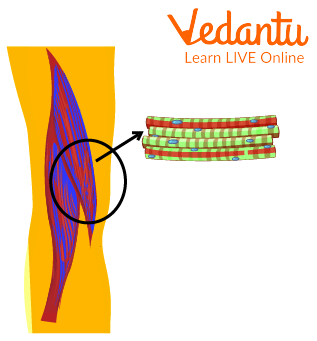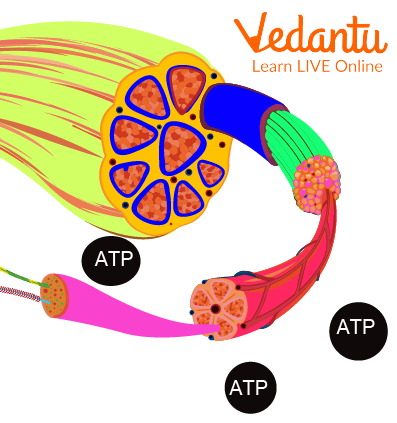




An Overview of Muscle Work
Running fast when a dog is behind? Or taking a body part away from any sensation of hot and cold. Ever wondered how are we able to do such things? The answer is with the help of our muscles. Even when we are smiling or just sitting in a position, our muscles are always working. They help in the beating of the heart, they let us use our mouth to communicate, and much more are the work of our muscles. Today in this article, we will learn all about our muscles and how muscles work and much more. So let's start learning.
What is Muscle?
Muscles are soft tissue which is present in both animals and humans. Actin and myosin are protein filaments which are found in the cells of the muscle. These filaments slide over one another which causes changes in the length and shape of the muscle cell, causing contraction in the muscle.
Types of Muscle
There are three types of muscle found in our body namely skeletal, smooth, or involuntary and cardiac muscles.

Types of Muscle
Skeletal Muscles
These muscles have dark and light staining to them due to which they appear striated. They are attached to our bones like strings.
They help to keep our skeleton in place and also help in movement.
These muscles are voluntary which means are under our control due to which we can use them by choice for movements and locomotion.

Skeletal Muscles
Smooth or Involuntary Muscles
These muscles have a smooth appearance and do not have any striation.
They are not under our direct control but rather are controlled by our nervous system, due to which they are called involuntary muscles.
These muscles line our digestive tract and blood vessels. They are working continuously throughout the day for our well-being and are not easily tired.

Smooth Muscles
Cardiac Muscles
The musculature found in the heart is called cardiac muscle.
The walls of heart chambers which are atria and ventricles are all made up of muscles. They are rhythmic and powerful and pump blood to the entire body.
They are involuntary in nature.

Cardiac Muscles
How do Muscles Work?
Muscle movements are controlled and coordinated which helps in the movement of various parts of the body. Usually, muscles work in pairs but before learning that let's learn how muscles are made. Muscles are composed of two kinds of fibres namely actin and myosin. Actin is usually thin and myosin is thick and is called thin and thick filaments, respectively. These filaments usually work together at the expense of energy.

Muscle Fibres and usage of ATP
The movement of muscles is controlled by the nervous system. Signals from the motor neurons are sent to target muscles and cause movement of the desired body part voluntarily. Whereas the involuntary contraction of smooth muscles is controlled by the nervous system and its secretions. When you run, the messages to and from the brain are more rigorous as many muscles have to work together. Muscles move the desired body parts by contracting and relaxing.
Muscles are Team Players
As mentioned earlier, Muscles work in pairs. Muscles can only pull bones but can't push them back to the mean position. This concludes that when muscles work they work in pairs of flexors and extensors. The flexor contracts to bend an appendage or limb at a joint. Then, when the movement is completed, the flexor relaxes and the extensor contracts to extend or straighten the limb at the same joint and the mean position is attained. For example, when we bend our elbow, the biceps muscles contract. Then the biceps relax and the triceps contract to straighten the elbow.

Working of Biceps and Triceps
The structural and functional unit of muscles is called sarcomere in which actin and myosin fibres are arranged alternately. The muscles are packed into bundles called fascicles. The endoplasmic reticulum of the sarcomere is called the sarcoplasmic reticulum which is rich in Calcium ions which play a role in the polarisation of the muscle fibres by binding with actin filaments.
Muscles of Leg (Leg Muscles - Thigh)
There are mainly two muscle groups present in your upper leg, also called thigh muscles, including back thigh muscles and front thigh muscles called quadricep muscles.
They are as follows:
Quadriceps Muscles - This muscle group is present in the front thigh which is the strongest and largest muscle in the human body. They work to straighten or extend your leg.
Hamstring Muscles and Hamstring Muscle Action - This muscle group is present in the back of your thigh (back thigh muscles). They are mainly used to bend the knees. The hamstring muscle action is used to perform various functions like climbing stairs, running, walking, etc.

Quadriceps and Hamstring Muscles
Muscle Power
Muscular power refers to the greatest force that is produced over a short period, such as while explosive jumping or throwing punches.
Muscle Endurance
When a little force is maintained for a long time during sports like skipping or swinging. It also plays a big role in almost every athletic endeavour. Long-distance running like the marathon is a sport that requires muscular endurance.
Summary
Muscles are specialised to generate potential and cause the movement of joints in the human body. Without muscles, we wouldn't have been able to even sit on our backs or read or write. Sometimes the muscles can be damaged due to any genetic or autoimmune disorder or can also be damaged due to serious injuries in those cases people are bound to beds or wheelchairs and have to depend on others for their daily needs. Now as we have learnt about the functioning of muscles and how they help in our body movements, we can appreciate the fact that without muscles, there would have been zero lively movements in our lives. Muscles are used for blinking our eyes, lifting things off the tables, writing and also to pump blood into all the parts of our body.
FAQs on Muscles
1. What is a muscle and what is its primary function in the body?
A muscle is a specialised tissue composed of cells that can contract, enabling movement and maintaining posture. The primary function of the muscular system is to convert chemical energy into mechanical force. This force is used for various bodily functions, including producing movement, stabilising joints, maintaining posture, and generating heat to regulate body temperature.
2. What are the three main types of muscles found in the human body?
The human body contains three distinct types of muscles, each with a specific structure and function:
- Skeletal Muscles: These are voluntary muscles attached to bones by tendons. They are responsible for all voluntary movements, like walking and lifting. They appear striped or 'striated' under a microscope.
- Smooth Muscles: These are involuntary muscles found in the walls of internal organs such as the stomach, intestines, and blood vessels. They manage internal processes like digestion and blood pressure regulation without conscious control.
- Cardiac Muscle: This is an involuntary, striated muscle found only in the heart. Its continuous, rhythmic contractions are responsible for pumping blood throughout the body.
3. What is the main difference between voluntary and involuntary muscles?
The main difference lies in their control mechanism. Voluntary muscles, like the skeletal muscles in your arms and legs, are under your conscious control. You can decide when to move them. In contrast, involuntary muscles, such as the cardiac muscle of the heart and smooth muscles in the digestive tract, operate automatically without conscious thought. Their function is regulated by the autonomic nervous system to maintain vital life processes.
4. How do muscles and bones work together to produce movement?
Muscles and bones work together as a lever system to create movement. Muscles are attached to bones via strong connective tissues called tendons. When a muscle receives a signal from the nervous system, it contracts or shortens. This contraction pulls on the tendon, which in turn pulls the bone, causing it to move at a joint. Muscles typically work in pairs; while one muscle contracts (the agonist), its opposing muscle relaxes (the antagonist) to allow for smooth, coordinated motion.
5. Why do muscles get sore or fatigued after strenuous exercise?
Muscle soreness and fatigue after intense exercise are primarily caused by two factors. During vigorous activity, your muscles may use oxygen faster than your blood can supply it. To continue producing energy, they switch to anaerobic respiration. This process leads to a build-up of lactic acid, which causes a burning sensation and fatigue. The soreness that appears a day or two later, known as Delayed Onset Muscle Soreness (DOMS), is due to microscopic tears in the muscle fibres that occur during the workout.
6. How do muscles grow larger and stronger through exercise?
Muscles grow through a process called muscle hypertrophy. When you perform resistance exercises like weightlifting, you create tiny micro-tears in your muscle fibres. In response, the body initiates a repair process. It not only repairs the damaged fibres but also adds new muscle protein strands, called myofibrils. Over time, this repeated process of damage and repair causes the muscle fibres to increase in thickness and number, resulting in larger and stronger muscles.
7. Are muscles completely at rest when the body is not moving?
No, even when you are seemingly at rest, most of your skeletal muscles are in a state of slight, continuous contraction known as muscle tone. This resting tension does not produce active movement but keeps the muscles firm, healthy, and ready to respond to stimuli. Muscle tone is crucial for maintaining posture and balance, even when you are not consciously thinking about it.
8. What are some common disorders that affect the muscular system?
Several disorders can affect the function of muscles. Two common examples are:
- Muscular Dystrophy: A group of genetic diseases characterised by the progressive weakness and degeneration of skeletal muscles. Over time, muscle fibres are damaged and replaced with fat and connective tissue.
- Myasthenia Gravis: An autoimmune disorder where the body's immune system mistakenly attacks and weakens the communication points (neuromuscular junctions) between nerves and muscle fibres, leading to muscle weakness and fatigue.









